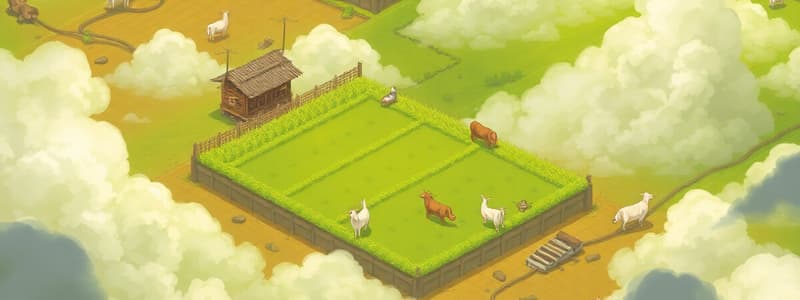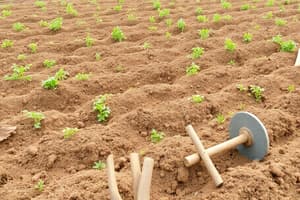Podcast
Questions and Answers
Agriculture is essentially the science and art of producing crops and livestock for what purpose?
Agriculture is essentially the science and art of producing crops and livestock for what purpose?
- Economic (correct)
- Recreational
- Environmental
- Nutritional
What Latin word refers to cultivation within the context of agriculture?
What Latin word refers to cultivation within the context of agriculture?
- Cultura (correct)
- Terra
- Ager
- Arbor
What activity constitutes raising plants and livestock under human management?
What activity constitutes raising plants and livestock under human management?
- Subsistence Farming
- Hunting and Gathering
- Agriculture (correct)
- Horticulture
Which of these is concerned with the management and marketing of agricultural products?
Which of these is concerned with the management and marketing of agricultural products?
What is the term for dealing with the diseases and treatments of animals?
What is the term for dealing with the diseases and treatments of animals?
Flashcards
What is agriculture?
What is agriculture?
Agriculture is both the science and art of producing crops and livestock for economic purposes, utilizing natural resources.
Primary aim of agriculture?
Primary aim of agriculture?
Agriculture aims to maximize land productivity while protecting it from deterioration and misuse.
What is agriculture?
What is agriculture?
Agriculture is the systematic raising of plants and livestock, a purposeful interaction with nature for human needs.
Agriculture as a business?
Agriculture as a business?
Signup and view all the flashcards
When did farming start?
When did farming start?
Signup and view all the flashcards
Study Notes
What is Agriculture?
- Agriculture is derived from the Latin words "Ager" (land/field) and "Cultura" (cultivation)
- Agriculture involves the cultivation of land
- It refers to the science and art of producing crops and livestock for economic purposes
- Agri also refers to producing crops and livestock and extracting from the earth's natural resources
Aim of Agriculture
- The goal is to cause the land to produce more abundantly
- it's also about protecting land from deterioration and misuse
Definitions of Agriculture
- Agriculture is a systematic raising of plants and livestock under human management
- It Is purposeful work aimed at the harnessing nature to produce plants and animals to meet human needs
- Agriculture is a broad industry involved with plant and animal production for food and fiber
- It involves supplying agricultural supplies and services, as well as processing, marketing, and distributing agricultural products
Agriculture: Art, Science, Business
- It requires using knowledge to skillfully operate a farm
- Agriculture involves physical and mental skill, modern tech, and scientific principles
- Modern Tech also helps to maximize yield and profit
- Examples of these modern technologies are hybridization, transgenic crops, and biotechnology
- Agriculture aims for substantial net return via land, labor, water, and capital management
- Knowledge of various sciences help with the production of food, feed, fiber, and fuel
- Agriculture is now commercialized and run as a business with mechanization
Branches of Agriculture
- Crop Science: Focuses on economic plants like rice, jute, and potatoes
- Animal Husbandry: Deals with animal production, such as cattle, buffalo, goats, and poultry
- Veterinary Medicine: Specializes in animal diseases and treatments
- Fisheries: Focuses on pisciculture (rearing and managing fish)
- Agricultural Engineering: Focuses on farm mechanization
- Agricultural Economics: Deals with economic management and marketing of agricultural products
- Agro-forestry: Integrated crop and forest plants production
Importance of Agriculture: Food
- Provides food such as cereals, sweet potatoes (Carbohydrates)
- Provides meat, fish, eggs (Protein)
- Provides mustard, grape seed, sunflower (Fat)
- Provides fruits, vegetables (Vitamins/Minerals)
Importance of Agriculture: Clothes
- Fiber for clothing comes from agriculture
- Cotton accounts for 70% of the fiber
- Other sources are jute, wool, and silk
Importance of Agriculture: Houses
- Maximum domestic materials are produced from agriculture
- These include timber, bamboo, straw and rope
Importance of Agriculture: Industry
- Raw materials from agriculture are also used in industry
- Includes medicine, Lumber, rubber, Perfume, Bakery and Leather industries
Importance of Agriculture: Fuel
- Brick fuel, coal, petrol and gases are attained from plants
- Biodiesel from Jatropha plants is a recent idea
Importance of Agriculture: Earning Source
- Agriculture can be a primary source of income
- Approximately 62% are engaged with money or crop and 47.5% of all people are involved with agriculture
Importance of Agriculture: Foreign Currency
- Agriculturally related products may be exported for income
- These include rice, wheat, prepared food
Importance of Agriculture: International Relations
- Agriculture promotes trade with other nations
Importance of Agriculture: Revenue and Income
- Revenue comes from taxing land and agricultural product
Importance of Agriculture: Natural Beauty
- Farming has aesthetic qualities
- These include the ornamental plant and implemented earthworks
Importance of Agriculture: Environmental Balance
- Plants help remove contaminants and balance the environment
Origins of Agriculture
- It forms civilization and facilitates the habitation of 7.5B
- It is the origin of civilization and caused changes in biology/society
Origin of Agriculture;
- Life history theory = to reproduce
- Variance compensation hypothesis = families were a burden on the move
- Neolitihic Demographic transition hypothesis = survival was prioritized
- Malthusian theory= human outpaced resources
- Boserup's theory = innovation is born from survival
The Great Start
- Roughly 9000-11700 years ago during warmer times
- Mesopotamia and towards the Fertile Crescent were the location (Middle East)
- It was founded by Natufian (hunter, gatherer) and pre-pottery cultures
- Wheat and barley were developed here
Vavilov's Centers of Origin
- Chinese center: Millet, barley, soybean, onion
- Indian center: Rice, mango, banana, coconut
- Central Asiatic center: Apples, cotton, lentil, garlic
- Near-eastern center: legumes and cereals
- Mediterranean center: flax, clover, asparagus
- Abyssinian center: Sorghum, castor bean, sesame, okra
- Central American center: Maize, pumpkin, cacao
- South American center: Potato, peanut, common bean, rubber
Why the Great Start
- By Divine Guidance
- Due to the Stress and gathering of Harlan and others
How Great Start
- Adaptations, Oasis Theory, or Broad revolution
The Eras:
- Pre-historic (Foraging)
- Neolithic (Farming)
- Ancient (Early civilization, irrigation and plows)
- Medieval (Crop rotation and organic)
- early modern (Columbian and breeding)
- Industrial (enclosure and movement by machines)
- Green (synthetics)
- Modern (climate based smart technology)
The Great Agrarian Systems:
- Slash it open and abandon
- Hydraulic (irrigation like Egypt)
- Hill (Inca)
- Animal power
- Early modern (rotation of all)
- Motorized
World Agriculture in 2022
- The world has a population of 7.95B
- 129.94M Km2 are dedicated to it
- 10.8% are harvestable
- 30.7% are forrested
- 36.9% total in total
World Agrarian Crisis
- Includes: land degradation, infra and capital
Agriculture in Phillipines
- The Philippines have a number of Islands and economic depression
Philippine Agriculture Development Programs:
- Intense Rice Production
- Agrarian Reform Plan
- Enhance livelihood with Agri
- Promote Global competition
- Encourage production and farmers co-op
Studying That Suits You
Use AI to generate personalized quizzes and flashcards to suit your learning preferences.




